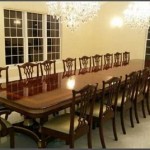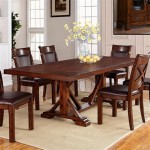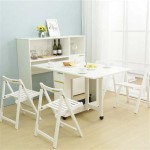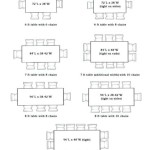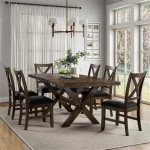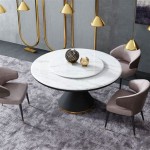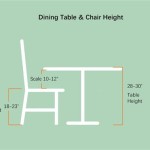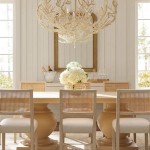Long Wood Dining Room Table
A long wood dining room table serves as a centerpiece, anchoring the dining space and facilitating gatherings. Its substantial length caters to larger families and frequent entertainers, providing ample seating and surface area. The material choice of wood imbues the table with natural warmth and character, complementing a variety of decor styles. Selecting the right long wood dining room table involves careful consideration of several factors including dimensions, wood type, style, and finish.
Dimensions and Seating Capacity
The dimensions of a long wood dining room table dictate its seating capacity and overall presence in the room. Standard table heights typically fall between 28 and 30 inches. Widths vary but generally range from 36 to 42 inches. The length is the most variable dimension, with options ranging from six feet to well over twelve feet, accommodating anywhere from six to fourteen or more diners. It's crucial to measure the dining area carefully, ensuring adequate space for the table and chairs, as well as comfortable movement around the furniture. Allow for at least 36 inches of clearance between the table edge and surrounding walls or furniture.
Wood Species and Their Characteristics
Various wood species are utilized in crafting long dining tables, each possessing unique characteristics that impact durability, aesthetics, and cost. Hardwoods like oak, maple, and cherry are known for their strength and resistance to dents and scratches. Oak offers a prominent grain pattern and can be stained in a wide range of colors. Maple is a denser wood with a smoother, more uniform grain. Cherry exhibits a rich, reddish-brown hue that deepens with age. Softer woods like pine are more budget-friendly but susceptible to damage. Reclaimed wood offers a unique, rustic appeal and contributes to sustainable practices. The chosen wood species significantly influences the table's overall style and longevity.
Table Styles and Design Elements
Long wood dining tables encompass a diverse array of styles to complement various interior design aesthetics. Traditional styles often feature ornate carvings, intricate details, and darker wood finishes. Contemporary designs prioritize clean lines, simple silhouettes, and lighter wood tones or painted finishes. Farmhouse styles embrace a rustic aesthetic, incorporating distressed wood, planked tops, and trestle bases. Mid-century modern designs often feature tapered legs and streamlined forms. The table's style should harmonize with the existing décor and reflect the homeowner's personal preferences.
Finish Options and Maintenance
The finish applied to a long wood dining table protects the surface and enhances its visual appeal. Common finishes include lacquer, varnish, and oil. Lacquer provides a durable, high-gloss finish that resists spills and scratches. Varnish offers a slightly softer sheen and good protection. Oil finishes penetrate the wood, enhancing its natural grain and providing a more matte appearance. Regular maintenance is essential to preserve the finish and prevent damage. Dusting regularly, using coasters and placemats, and addressing spills promptly are crucial for maintaining the table's beauty and longevity.
Considering the Base and Support
The base of the table significantly contributes to its stability and overall aesthetic. Common base styles include pedestal, trestle, and four-leg designs. Pedestal bases offer unobstructed legroom and a clean, modern look. Trestle bases provide excellent support for long tables and contribute to a rustic or farmhouse aesthetic. Four-leg designs offer stability and a classic look. The choice of base should complement the table's style and ensure adequate support for the tabletop.
Budget and Investment
Long wood dining tables represent a significant investment, with prices varying considerably based on factors like size, wood species, design complexity, and brand. Setting a budget beforehand helps narrow down the options and ensures a financially sound decision. While cost is a factor, it's important to prioritize quality and durability. A well-crafted, solid wood dining table can last for generations, becoming a cherished heirloom passed down through the family.
Extending the Table's Lifespan
Proper care and maintenance are crucial for maximizing the lifespan of a long wood dining table. Protecting the surface from heat, moisture, and sharp objects is essential. Using coasters, placemats, and trivets helps prevent damage from hot dishes and spills. Cleaning up spills promptly prevents staining and water damage. Periodically applying a wood conditioner or polish can help maintain the finish and prevent drying or cracking. Following manufacturer's care instructions ensures the table remains beautiful and functional for years to come.

Large Farmhouse Table Long Farm Dining Room Custom Wood Barn Distressed Kitchen Etsy

Our S Insimbi Designs

Live Edge Dining Tables For Custom Kitchen Pathway

Long Skinny Dining Table Visualhunt

Wood Dining Table Farmhouse 70 8 Kitchen For 6 People

Plank Farm Table Breadboard Ends Dutchcrafters Dining Tables

Sobu Oakland Designed And Handpicked Furniture

Wood Tables With Benches Photos Ideas

Rustic Farmhouse Clifford Dining Table Reclaimed Wood Handmade Kitchen X Wooden Base

Custom Live Edge Dining Table Kitchen Black Walnut Office Wooden Slab Etsy

